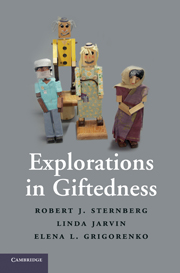Book contents
- Frontmatter
- Contents
- Preface
- 1 What Is Giftedness?
- 2 Theories of Giftedness
- 3 WICS as a Model of Giftedness
- 4 Intelligence and Giftedness
- 5 Creativity and Giftedness
- 6 Wisdom and Giftedness
- 7 Giftedness as Developing Expertise
- 8 Giftedness and Culture
- 9 Learning Disabilities, Giftedness, and Gifted/LD
- 10 Identifying the Gifted
- 11 Educating the Gifted
- References
- Index
11 - Educating the Gifted
Published online by Cambridge University Press: 05 June 2012
- Frontmatter
- Contents
- Preface
- 1 What Is Giftedness?
- 2 Theories of Giftedness
- 3 WICS as a Model of Giftedness
- 4 Intelligence and Giftedness
- 5 Creativity and Giftedness
- 6 Wisdom and Giftedness
- 7 Giftedness as Developing Expertise
- 8 Giftedness and Culture
- 9 Learning Disabilities, Giftedness, and Gifted/LD
- 10 Identifying the Gifted
- 11 Educating the Gifted
- References
- Index
Summary
More and more, educators are recognizing that many children, including gifted children, fail to live up to their potential. There can be a number of reasons for this failure, but one reason is that the way students are taught and often assessed in school does not enable them to learn and perform in an optimal way. We have developed the WICS theory (wisdom, intelligence, creativity, synthesized) to understand these children (Sternberg, 1997a, 1999c), and have developed a set of methods of teaching for successful intelligence to help these students reach their full potential (Sternberg & Grigorenko, 2000, 2007b; Sternberg, Grigorenko, & Zhang, 2008; Sternberg, Jarvin, & Grigorenko, 2009).
TEACHING AND ASSESSING THE GIFTED FOR WICS
We have developed several principles for teaching:
Because students have different life goals and hence different outcomes that, for them, are successful, student success needs to be defined in terms that are meaningful to the students as well as to the institution.
Students take courses for many reasons. How can teachers translate such a wide range of needs into effective teaching and assessment strategies?
- Type
- Chapter
- Information
- Explorations in Giftedness , pp. 213 - 236Publisher: Cambridge University PressPrint publication year: 2010

